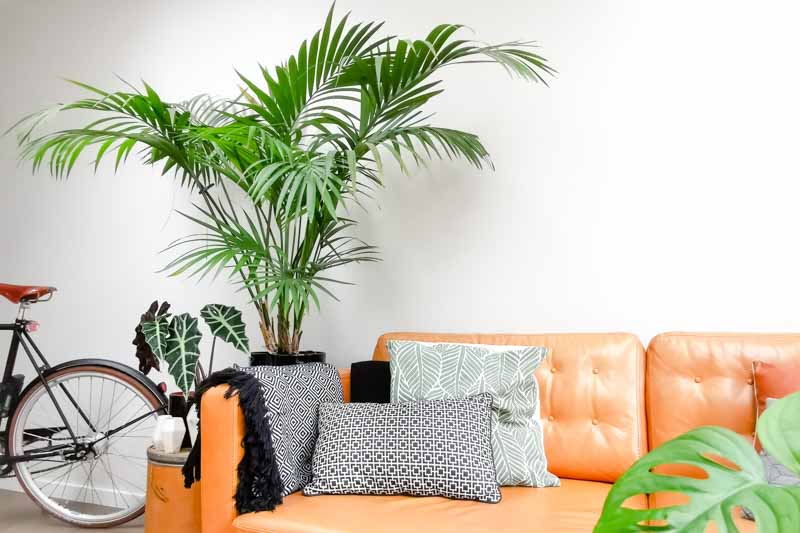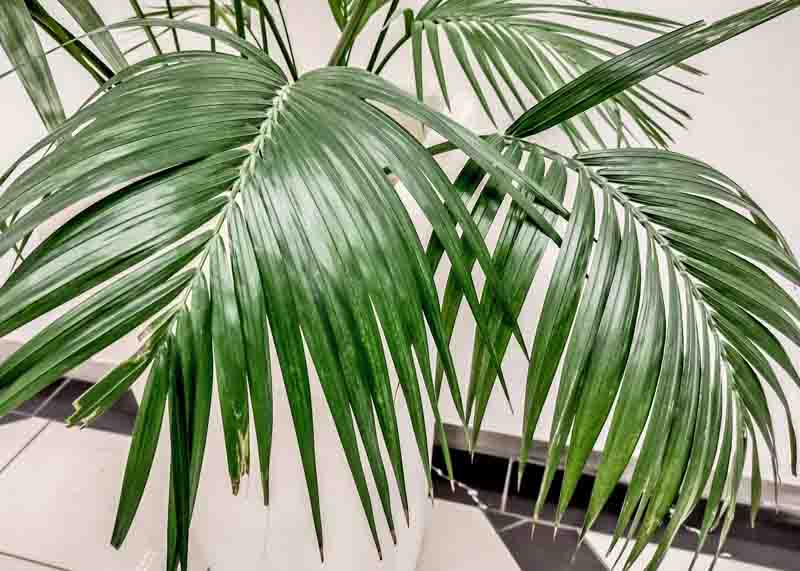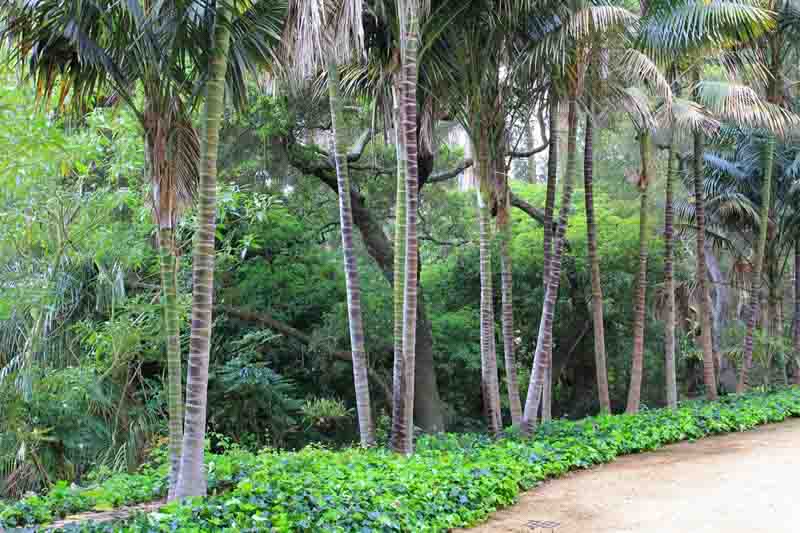Forster Sentry Palm, Kentia Palm, Paradise Palm, Sentry Palm, Thatch Palm
Howea forsteriana or Kentia Palm stands out for its lush, tropical appearance and adaptability. It is ideal for adding a touch of elegance to indoor spaces while being relatively easy to care for compared to other palms.
Howea forsteriana is celebrated for its elegant, arching fronds and slender trunk, making it a favored ornamental palm. Its graceful appearance and tolerance for indoor conditions have made it a popular choice for interior landscapes.
Native: This palm is native to Lord Howe Island, off the eastern coast of Australia, where it thrives in dense colonies in the island’s understorey. Kentia Palm belongs to the palm family (Arecaceae), like the Christmas Palm, Majesty Palm, or Areca Palm.
Plant Type and Habit: The Kentia Palm is a slow-growing, evergreen palm with a single trunk in its natural habitat but often cultivated with multiple trunks in pots. Its upright habit and arching fronds create a canopy-like effect.
Size: Indoors, Kentia Palms can reach heights of 5 to 12 feet (1.5 to 3.6 meters), with a spread of 3 to 5 feet (0.9 to 1.5 meters). In their natural habitat, they can grow much taller, up to 40 feet (12 meters) and 6-10 feet wide (1.8 to 3 meters).
Flower: The Kentia Palm produces small, inconspicuous white to cream flowers arranged in clusters along stalks that emerge from the base of the fronds. Flowering typically occurs in mature palms, mainly when grown outdoors, and is not commonly seen in indoor settings. Following flowering, it produces small, egg-shaped, reddish-brown fruits that are insignificant in indoor cultivation.
Foliage: Its dark green, glossy fronds can grow up to 5 feet long (1.5 meters) and consist of numerous leaflets that give it a feather-like appearance. Each leaf can have up to 90 leaflets that bend downward.
Trunk: The trunk is ringed with the scars of shed fronds, giving it a somewhat rough texture.
Hardiness: It’s hardy in USDA zones 9b to 11 and prefers temperatures between 65°F to 75°F (18°C to 24°C), not tolerating frost.
Award: Recipient of the prestigious Award of Garden Merit of the Royal Horticultural Society.
Uses: Widely used as an indoor plant due to its low-light tolerance, it’s also planted outdoors in subtropical and tropical regions for landscaping.
Toxicity: Kentia Palm is non-toxic to humans and pets, making it a safe household choice.
Benefits: In addition to its ornamental value, it improves indoor air quality by filtering out pollutants, contributing to a healthier living environment.

The Kentia Palm, with its graceful profile and resilience, is an ideal indoor plant that brings a touch of the tropics to any space. Here’s how to grow and care for this elegant palm:
Light: When grown indoors, Kentia Palm prefers bright, indirect light. It should be placed near a window that receives plenty of light but where the sun’s rays never directly touch the foliage. An east-facing window with gentle morning sunlight or a north-facing window with consistent but filtered light throughout the day are ideal. The palm can tolerate low-light conditions; however, lower light may slow its growth and reduce the lushness of its fronds.
Outdoors, Kentia Palm thrives in a spot with filtered sunlight or partial shade, especially in hot climates. If it’s placed in an area that receives direct sunlight, it should be limited to the morning sun, which is less intense. In cooler climates, the palm can handle more direct sunlight, but always be cautious of midday sun, which can scorch the leaves.
Soil: Use a well-draining potting mix, such as a mix formulated specifically for palms or a general-purpose mix amended with perlite or sand to improve drainage.
For outdoor growth, Kentia Palm flourishes in well-draining, loamy soil enriched with organic matter. The ideal pH is slightly acidic to neutral. Amend heavy soils with compost or peat to improve drainage and aeration, fostering a robust root system for this stately palm.
Water: Water when the top inch of the soil feels dry. Kentia Palms prefer consistent moisture, but it’s crucial not to overwater, as this can lead to root rot. Reduce the frequency of watering in winter.
Temperature and Humidity: Kentia Palms thrive at average room temperatures between 65°F and 85°F (18°C – 29°C). They do not tolerate cold drafts or temperatures below 55°F (12°C). This palm enjoys a humid environment, so consider misting it regularly or placing a humidifier nearby, especially in drier climates or during winter months when indoor heating can reduce humidity levels.
Fertilization: Feed the Kentia Palm with a balanced, water-soluble fertilizer every month during the growing season (spring and summer). In the fall and winter, reduce fertilizing to every other month or less.
Pruning: Remove only the brown, dead fronds from the plant’s base. Avoid cutting back or pruning healthy fronds, as this can damage the plant.
Cleaning: Wipe down leaves with a damp cloth to prevent dust accumulation, which can attract pests.
Repotting: Repot every 2-3 years or when the palm has outgrown its pot. Choose a container only one size larger, as too much space can lead to waterlogged soil.

Propagating Kentia Palm (Howea forsteriana) is a process that requires patience, as it is typically slow-growing and propagated by seed, which can take a considerable amount of time to germinate. Unlike many other houseplants, Kentia Palms are not easily propagated through cuttings or division. Here is a general guide to propagating Kentia Palms from seeds:
Because of the slow growth rate and specific needs of Kentia Palm seedlings, this palm is often more practical to purchase as a young plant rather than starting from seed.

Kentia Palm is relatively resistant to pests and diseases, especially when properly cared for. However, like any indoor plant, it can encounter problems if its growing conditions are not ideal.
Spider mites: These tiny pests thrive in dry conditions and can cause the foliage to look dull and stippled. Increase humidity and wash the plant with water. In severe cases, use insecticidal soap or neem oil.
Mealybugs: Recognizable by their cotton-like white masses, they suck plant sap, weakening it. Remove them manually using a cotton swab dipped in rubbing alcohol or apply insecticidal soap.
Scale insects: These can appear as small brown bumps on the stems and leaves, sucking the sap and reducing plant vigor. Scrape them off or treat them with neem oil.
Root rot: This is the most common disease for Kentia Palms, often resulting from overwatering and poor drainage.
Leaf spot diseases: Fungal or bacterial leaf spots can occur, especially in humid conditions or when foliage is frequently wet.
Brown Tips: This could be due to low humidity, over-fertilizing, or build-up of salts from tap water. Regular misting and using filtered water can help.
Yellow Leaves: Overwatering is the usual suspect when leaves turn yellow. Make sure to let the soil dry out between watering sessions.
Slow Growth: If a Kentia Palm is not growing as expected, it might not get enough light or nutrients.
Potassium Deficiency: Necrosis starting at the tips of the oldest leaves and progressing backward toward the stem. Apply a palm-specific fertilizer that contains an adequate amount of potassium, along with other essential nutrients.
Manganese Deficiency: Necrosis at the tips of the leaflets on the newest leaves, often occurring with a yellowing of the leaf edges. Treat with a manganese supplement or a balanced, micronutrient-rich fertilizer suitable for palms.
Boron Deficiency: New leaves may appear stunted or distorted with abnormal growth patterns. Use a fertilizer with a complete micronutrient package that includes boron to prevent and correct the deficiency.

Yes, Kentia Palm (Howea forsteriana) is an excellent indoor plant. It’s known for its elegant appearance, air-purifying qualities, and adaptability to indoor conditions. It thrives in a wide range of light conditions, from low to bright, indirect light, and prefers consistent moisture without being waterlogged. Its tolerance for lower light and ability to improve air quality make it a popular choice for homes and offices.
Water your Kentia Palm when the top inch of soil feels dry to the touch, typically once a week, but adjust based on the humidity and light conditions of your home. Overwinter, when growth slows, reduce watering frequency. It’s crucial to ensure good drainage to prevent root rot.
Kentia Palms can have a long lifespan, often several decades, especially when cared for properly. Their longevity is one of the reasons they are valued as indoor plants.
Kentia Palms prefer bright, indirect light indoors but can tolerate lower light levels. They can also adapt to direct sunlight if acclimated gradually, but harsh, direct midday sun should be avoided to prevent leaf burn.
| Hardiness |
9 - 11 |
|---|---|
| Plant Type | Houseplants, Palms - Cycads |
| Plant Family | Arecaceae |
| Exposure | Partial Sun |
| Season of Interest |
Spring (Early, Mid, Late) Summer (Early, Mid, Late) Fall Winter |
| Height |
5' - 40' (150cm - 12.2m) |
| Spread |
3' - 10' (90cm - 3m) |
| Maintenance | Low |
| Water Needs | Average |
| Soil Type | Loam |
| Soil pH | Acid, Neutral |
| Soil Drainage | Well-Drained |
| Characteristics | Showy, Evergreen, Plant of Merit |
| Native Plants | Australia |
| Garden Uses | Beds And Borders, Patio And Containers |
| Garden Styles | Mediterranean Garden |
| Hardiness |
9 - 11 |
|---|---|
| Plant Type | Houseplants, Palms - Cycads |
| Plant Family | Arecaceae |
| Exposure | Partial Sun |
| Season of Interest |
Spring (Early, Mid, Late) Summer (Early, Mid, Late) Fall Winter |
| Height |
5' - 40' (150cm - 12.2m) |
| Spread |
3' - 10' (90cm - 3m) |
| Maintenance | Low |
| Water Needs | Average |
| Soil Type | Loam |
| Soil pH | Acid, Neutral |
| Soil Drainage | Well-Drained |
| Characteristics | Showy, Evergreen, Plant of Merit |
| Native Plants | Australia |
| Garden Uses | Beds And Borders, Patio And Containers |
| Garden Styles | Mediterranean Garden |
How many Howea forsteriana (Kentia Palm) do I need for my garden?
| Plant | Quantity | |
|---|---|---|
| Howea forsteriana (Kentia Palm) | N/A | Buy Plants |
Create a membership account to save your garden designs and to view them on any device.
Becoming a contributing member of Gardenia is easy and can be done in just a few minutes. If you provide us with your name, email address and the payment of a modest $25 annual membership fee, you will become a full member, enabling you to design and save up to 25 of your garden design ideas.
Join now and start creating your dream garden!
Create a membership account to save your garden designs and to view them on any device.
Becoming a contributing member of Gardenia is easy and can be done in just a few minutes. If you provide us with your name, email address and the payment of a modest $25 annual membership fee, you will become a full member, enabling you to design and save up to 25 of your garden design ideas.
Join now and start creating your dream garden!